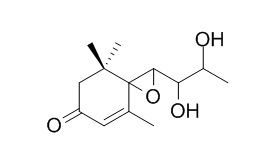Unedone
Unedone is a natural product from Lysimachia clethroides.
Inquire / Order:
manager@chemfaces.com
Technical Inquiries:
service@chemfaces.com
Tel:
+86-27-84237783
Fax:
+86-27-84254680
Address:
1 Building, No. 83, CheCheng Rd., Wuhan Economic and Technological Development Zone, Wuhan, Hubei 430056, PRC
Providing storage is as stated on the product vial and the vial is kept tightly sealed, the product can be stored for up to
24 months(2-8C).
Wherever possible, you should prepare and use solutions on the same day. However, if you need to make up stock solutions in advance, we recommend that you store the solution as aliquots in tightly sealed vials at -20C. Generally, these will be useable for up to two weeks. Before use, and prior to opening the vial we recommend that you allow your product to equilibrate to room temperature for at least 1 hour.
Need more advice on solubility, usage and handling? Please email to: service@chemfaces.com
The packaging of the product may have turned upside down during transportation, resulting in the natural compounds adhering to the neck or cap of the vial. take the vial out of its packaging and gently shake to let the compounds fall to the bottom of the vial. for liquid products, centrifuge at 200-500 RPM to gather the liquid at the bottom of the vial. try to avoid loss or contamination during handling.
J Nutr Biochem.2022, 107:109064.
Mol Med Rep.2024, 29(2):26.
J Appl Pharm Sci.2022, 12(04):044-053
Curr Issues Mol Biol.2022, 44(10):5106-5116.
BMC Plant Biol.2021, 21(1):60.
Oncol Rep.2016, 35(3):1356-64
Molecules.2019, 24(11):E2102
Plant Physiol Biochem.2023, 203:108073.
Malaysian J of Fundamental and Applied Sciences 2018, 14(3):368-373
Huazhong Agricultural University2022, pp34.
Related and Featured Products
J Agric Food Chem. 2010 Jan 13;58(1):384-9.
Floral markers of strawberry tree (Arbutus unedo L.) honey.[Pubmed:
19919097]
Strawberry tree honey, due to its characteristic bitter taste, is one of the most typical Mediterranean honeys, with Sardinia being one of the largest producers. According to specific chemical studies, homogentisic acid was identified as a possible marker of this honey.
METHODS AND RESULTS:
This work, based on HPLC-DAD-MS/MS analysis of strawberry tree (Arbutus unedo L.) honeys, previously selected by sensory evaluation and melissopalynological analysis, showed that, in addition to the above-mentioned acid, there were other high levels of substances useful for the botanical classification of this unifloral honey. Two of these compounds were isolated and identified as (+/-)-2-cis,4-trans-abscisic acid (c,t-ABA) and (+/-)-2-trans,4-trans-abscisic acid (t,t-ABA). A third compound, a new natural product named Unedone, was characterized as an epoxidic derivative of the above-mentioned acids. Structures of c,t-ABA, t,t-ABA, and Unedone were elucidated on the basis of extensive 1D and 2D NMR experiments, as well as HPLC-MS/MS and Q-TOF analysis. In selected honeys the average amounts of c,t-ABA, t,t-ABA, and Unedone were 176.2+/-25.4, 162.3+/-21.1, and 32.9+/-7.1 mg/kg, respectively.
CONCLUSIONS:
Analysis of the A. unedo nectar confirmed the floral origin of these compounds found in the honey.
Abscisic acids were found in other unifloral honeys but not in such high amount and with a constant ratio of about 1:1. For this reason, besides homogentisic acid, these compounds could be used as complementary markers of strawberry tree honey.



